Effects of Nanoparticle Additives on Spray Characteristics of Liquid Jets in Gaseous Crossflow
Abstract
:1. Introduction
2. Materials and Methods
2.1. Preparation and Properties of Nanofluids
2.2. Spray Experimental Facility
2.3. Image Processing
3. Results and Discussion
3.1. Flow Visualization
3.2. Breakup Regimes
3.3. Penetration Behaviors
3.4. Column Fracture Regularity
4. Summary and Conclusions
Supplementary Materials
Author Contributions
Funding
Acknowledgments
Conflicts of Interest
Nomenclature
| CD di dj dL dmax dp0 ΔR Fa Fσ h lc Oh Pep PV q Rej Rep S1 Scircle Sellipse tli ug uj ul w Weg X Z δ θ λc μ ν ρ σ φ | liquid column average drag coefficient width of liquid column cross-section, m liquid jet diameter at the nozzle exit, m equivalent diameter of water molecules, m length of liquid column cross-section, m mean diameter of monodispersed nanoparticles, m thickness of solvation layer, m aerodynamic drag force, N surface tension, N characteristic height of column cell, m cross-section perimeter of liquid column, m Ohnesorge number, particle Peclet number, nanofluids-jet parameter, jet momentum flux ratio, jet Reynolds number, particle Reynolds number, windward area of liquid column, m2 rounded cross-section area of liquid column, m2 elliptic cross-section area of liquid column, m2 onset of surface breakup time, s air crossflow velocity, m/s liquid velocity at the nozzle exit, m/s mean velocity of ligament in boundary layer, m/s mass fraction of nanoparticles, wt.% gas phase Weber number, non-dimensional x-coordinate, x/dj non-dimensional z-coordinate, z/dj thickness of liquid boundary layer, m angle between X axis and tangent of jet trajectory column wave length, m dynamic viscosity, Pa·s kinematic viscosity, m2/s density, kg/m3 surface tension, N/m volume fraction of nanoparticles, vol.% |
| Subscripts | |
| b bf g j L nf p ∞ | location of liquid column fracture basic fluid gas jet liquid nanofluids nanoparticle ambient gas |
References
- Wu, P.K.; Kirkendall, K.A.; Fuller, R.P.; Nejad, A.S. Breakup processes of liquid jets in subsonic crossflows. J. Propuls. Power 1997, 13, 64–73. [Google Scholar] [CrossRef]
- Zhang, H.B.; Bai, B.F.; Liu, L.; Sun, H.J.; Yan, J.J. Experimental study of the mixing of two impinging pressure-swirl sprays in crossflow. Exp. Therm. Fluid Sci. 2013, 49, 67–74. [Google Scholar] [CrossRef]
- Karagozian, A.R. Transverse jets and their control. Prog. Energy Combust. Sci. 2010, 36, 531–553. [Google Scholar] [CrossRef]
- Park, J.; Kim, T.; Kim, D.; Park, S. Prediction of wall impingement in a direct injection spark ignition engine by analyzing spray images for high-pressure injection up to 50 MPa. Fuel Process. Technol. 2018, 179, 238–249. [Google Scholar] [CrossRef]
- Broumand, M.; Birouk, M. Liquid jet in a subsonic gaseous crossflow: Recent progress and remaining challenges. Prog. Energy Combust. Sci. 2016, 57, 1–29. [Google Scholar] [CrossRef]
- Tambe, S.B.; Jeng, S.M.; Mongia, H.; Hsiao, G. Liquid Jets in Subsonic Crossflow. In Proceedings of the 43rd AIAA Aerospace Sciences Meeting and Exhibit, Reno, NV, USA, 10–13 January 2005. [Google Scholar]
- Sallam, K.A.; Aalburg, C.; Faeth, G.M. Breakup of round nonturbulent liquid jets in gaseous crossflow. AIAA J. 2004, 42, 2529–2540. [Google Scholar] [CrossRef] [Green Version]
- Brown, C.; McDonell, V. Near Field Behavior of a Liquid Jet in a Crossflow. In Proceedings of the ILASS-Americas, Toronto, ON, Canada, 23–26 May 2006. [Google Scholar]
- Song, J.; Cary Cain, C.; Guen Lee, J. Liquid jets in subsonic air crossflow at elevated pressure. J. Eng. Gas Turbine Power 2015, 137, 041502. [Google Scholar] [CrossRef]
- Iyogun, C.O.; Birouk, M.; Popplewell, N. Trajectory of water jet exposed to low subsonic cross-flow. At. Sprays 2006, 16, 963–980. [Google Scholar] [CrossRef]
- Das, S.K.; Kim, K.; Lim, O. Experimental study on non-vaporizing spray characteristics of biodiesel-blended gasoline fuel in a constant volume chamber. Fuel Process. Technol. 2018, 178, 322–335. [Google Scholar] [CrossRef]
- Broumand, M.; Birouk, M. A model for predicting the trajectory of a liquid jet in a subsonic gaseous crossflow. At. Sprays 2015, 25, 871–893. [Google Scholar] [CrossRef]
- Farvardin, E.; Dolatabadi, A. Simulation of Biodiesel Jet in Cross Flow. In Proceedings of the ICLASS 2012, 12th Triennial International Conference on Liquid Atomization and Spray Systems, Heidelberg, Germany, 2–6 September 2012. [Google Scholar]
- Stenzler, J.; Lee, J.; Santavicca, D. Penetration of Liquid Jets in a Crossflow. In Proceedings of the 41st Aerospace Sciences Meeting and Exhibit, American Institute of Aeronautics and Astronautics, Reno, NV, USA, 6–9 January 2003; pp. 887–906. [Google Scholar]
- Birouk, M.; Iyogun, C.O.; Popplewell, N. Role of viscosity on trajectory of liquid jets in a cross-airflow. At. Sprays 2007, 17, 267–287. [Google Scholar] [CrossRef]
- Stenzler, J.N.; Lee, J.G.; Santavicca, D.A.; Lee, W. Penetration of Liquid Jets in a Crossflow. At. Sprays 2006, 16, 887–906. [Google Scholar] [CrossRef]
- Lin, K.C.; Kennedy, P.J.; Jackson, T.A. A Review on Penetration Heights of Transverse Liquid Jets in High-Speed Flows. In Proceedings of the 15th Annual Conference on Liquid Atomization and Spray Systems, Madison, WI, USA, 14–17 May 2002; pp. 345–349. [Google Scholar]
- Lee, K.; Aalburg, C.; Diez, F.J.; Faeth, G.M.; Sallam, K.A. Primary breakup of turbulent round liquid jets in uniform crossflows. AIAA J. 2007, 45, 1907–1916. [Google Scholar] [CrossRef]
- Thawley, S.M.; Mondragon, U.M.; Brown, C.T.; Mcdonell, V.G. Evaluation of Column Breakpoint and Trajectory for a Plain Liquid Jet Injected into a Crossflow. In Proceedings of the ILASS-Americas 21st Annual Conference on Liquid Atomization and Spray Systems, Orlando, FL, USA, 18–21 May 2008; pp. 1–11. [Google Scholar]
- Ragucci, R.; Bellofiore, A.; Cavaliere, A. Breakup and breakdown of bent kerosene jets in gas turbine conditions. Proc. Combust. Inst. 2007, 31, 2231–2238. [Google Scholar] [CrossRef]
- McGrailn, B.P.; Thallapally, P.K.; Blanchard, J.; Nune, S.K.; Jenks, J.J.; Dang, L.X. Metal-organic heat carrier nanofluids. Nano Energy 2013, 2, 845–855. [Google Scholar] [CrossRef]
- Mahian, O.; Kianifar, A.; Heris, S.Z.; Wen, D.S.; Sahin, A.Z.; Wongwises, S. Nanofluids effects on the evaporation rate in a solar still equipped with a heat exchanger. Nano Energy 2017, 36, 134–155. [Google Scholar] [CrossRef]
- Mehta, R.N.; Chakraborty, M.; Parikh, P.A. Nanofuels: Combustion, engine performance and emissions. Fuel 2014, 120, 91–97. [Google Scholar] [CrossRef]
- Mardi, K.M.; Antoshkiv, O.; Berg, H.P. Experimental analysis of the effect of nano-metals and novel organic additives on performance and emissions of a diesel engine. Fuel Process. Technol. 2019, 196, 106166. [Google Scholar] [CrossRef]
- Manigandan, S.; Gunasekar, P.; Devipriya, J.; Nithya, S. Emission and injection characteristics of corn biodiesel blends in diesel engine. Fuel 2019, 235, 723–735. [Google Scholar] [CrossRef]
- Nour, M.; El-Seesy, A.I.; Abdel-Rahman, A.K.; Bady, M. Influence of adding aluminum oxide nanoparticles to diesterol blends on the combustion and exhaust emission characteristics of a diesel engine. Exp. Therm. Fluid Sci. 2018, 98, 634–644. [Google Scholar] [CrossRef]
- Basu, S.; Miglani, A. Combustion and heat transfer characteristics of nanofluid fuel droplets: A short review. Int. J. Heat Mass Transf. 2016, 96, 482–503. [Google Scholar] [CrossRef]
- Gan, Y.N.; Qiao, L. Combustion characteristics of fuel droplets with addition of nano and micron-sized aluminum particles. Combust. Flame 2011, 158, 354–368. [Google Scholar] [CrossRef]
- Miglani, A.; Basu, S. Effect of particle concentration on shape deformation and secondary atomization characteristics of burning nanotitania dispersion droplet. ASME J. Heat Transf. 2015, 137, 102001. [Google Scholar] [CrossRef]
- Sonawane, S.; Patankar, K.; Fogla, A.; Puranik, B.; Bhandarkar, U.; Sunil Kumar, S. An experimental investigation of thermos-physical properties and heat transfer performance of Al2O3-aviation turbine fuel nanofluids. J. Appl. Therm. Eng. 2011, 31, 2841–2849. [Google Scholar] [CrossRef]
- Villarejoa, R.G.; Martínb, E.I.; Coronillac, A.S.; Aguilar, T. Towards the improvement of the global efficiency of concentrating solar power plants by using Pt-based nanofluids: The internal molecular structure effect. Appl. Energy 2018, 228, 2262–2274. [Google Scholar] [CrossRef]
- Kim, D.M.; Baek, S.W.; Yoon, J. Ignition characteristics of kerosene droplets with the addition of aluminum nanoparticles at elevated temperature and pressure. Combust. Flame 2016, 173, 106–113. [Google Scholar] [CrossRef]
- Kannaiyan, K.; Sadr, R. The effects of alumina nanoparticles as fuel additives on the spray characteristics of gas-to-liquid jet fuels. Exp. Therm. Fluid Sci. 2017, 87, 93–103. [Google Scholar] [CrossRef]
- Kannaiyan, K.; Anoop, K.; Sadr, R. Effect of nanoparticles on the fuel properties and spray performance of aviation turbine fuel. J. Energy Resour. Technol. 2017, 139, 032201. [Google Scholar] [CrossRef]
- Li, S.J.; Zhuo, Z.; He, L.J.; Huang, X.F. Atomization characteristics of nano-Al/ethanol nanofluid fuel in electrostatic field. Fuel 2019, 236, 811–819. [Google Scholar] [CrossRef]
- Bolszo, C.D.; McDonell, V.G.; Gomez, G.A.; Samuelsen, G.S. Injection of water-in-oil emulsion injection into a subsonic crossflow: An experimental study. At. Sprays 2014, 24, 303–348. [Google Scholar] [CrossRef] [Green Version]
- Tanvir, S.; Qiao, L. Surface tension of nanofluid-type fuels containing suspended nanomaterials. Nanoscale Res. Lett. 2012, 7, 226. [Google Scholar] [CrossRef] [Green Version]
- Zhu, D.S.; Li, X.F.; Wang, X.J. Experimental investigation on viscosity of Cu-H2O nanofluids. J. Wuhan Univ. Technol. Mater. Sci. 2008, 23, 436–441. [Google Scholar]
- Einstein, A. EineneueBestiininung der MoIekuldimensionen. Ann. Phys. 1906, 324, 289–306. [Google Scholar] [CrossRef] [Green Version]
- Faeth, G.M.; Hsiang, L.P.; Wu, P.K. Structure and breakup properties of sprays. Int. J. Multiph. Flow 1995, 21, 99–127. [Google Scholar] [CrossRef]
- Wang, Q.; Mondragon, U.M.; Brown, C.T.; McDonell, V.G. Characterization of trajectory, break point, and break point dynamics of a plain liquid jet in a crossflow. At. Sprays 2011, 21, 203–219. [Google Scholar] [CrossRef]
- Ng, C.L.; Sankarakrishnan, R.; Sallam, K.A. Bag breakup of nonturbulent liquid jets in crossflow. Int. J. Multiph. Flow 2008, 34, 241–259. [Google Scholar] [CrossRef]
- Liu, A.B.; Mather, D.; Reitz, R.D. Modeling the Effect of Drop Drag and Breakup on Fuel Sprays. SAE Trans. 1993, 102, 930072. [Google Scholar]


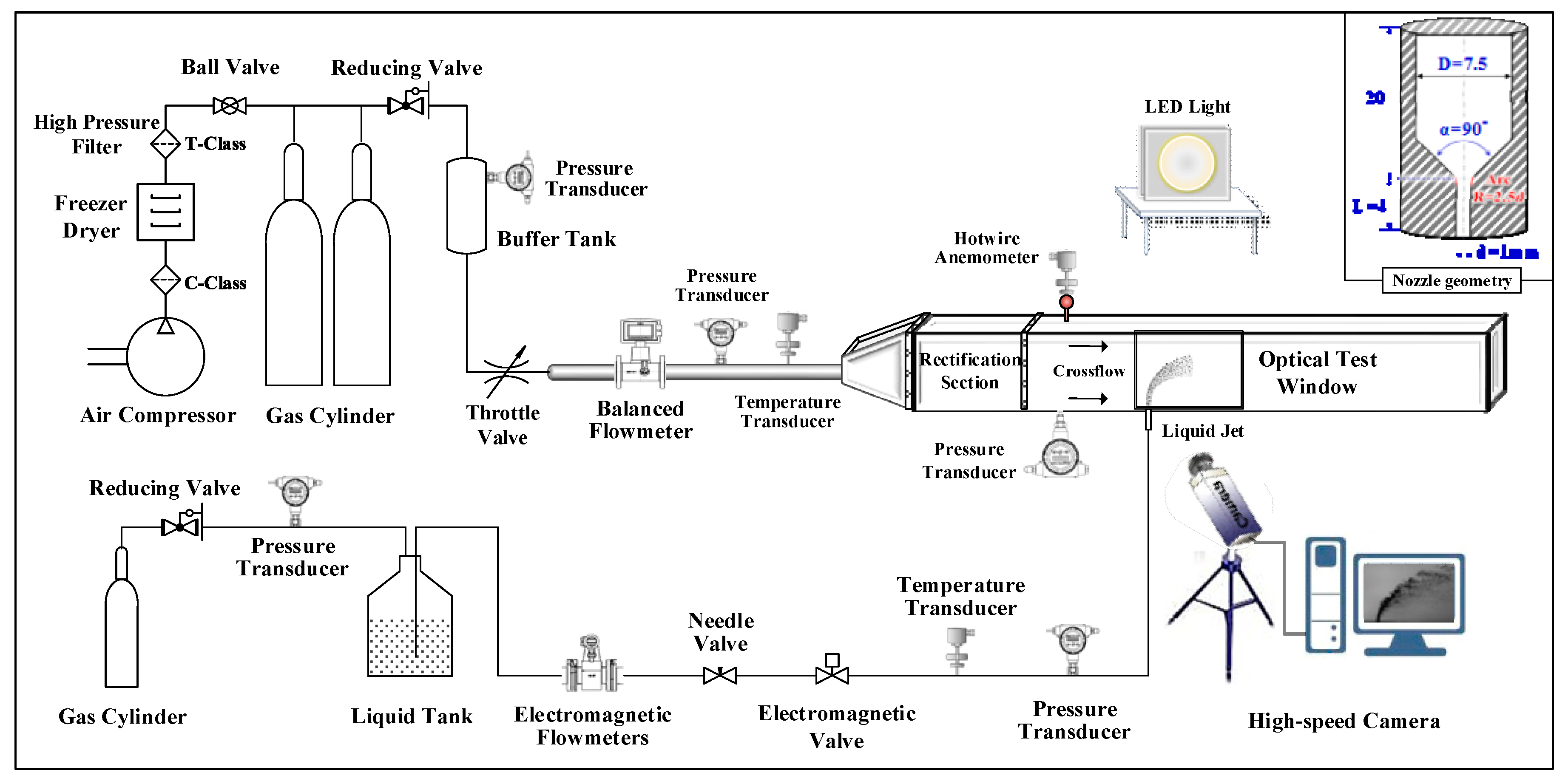
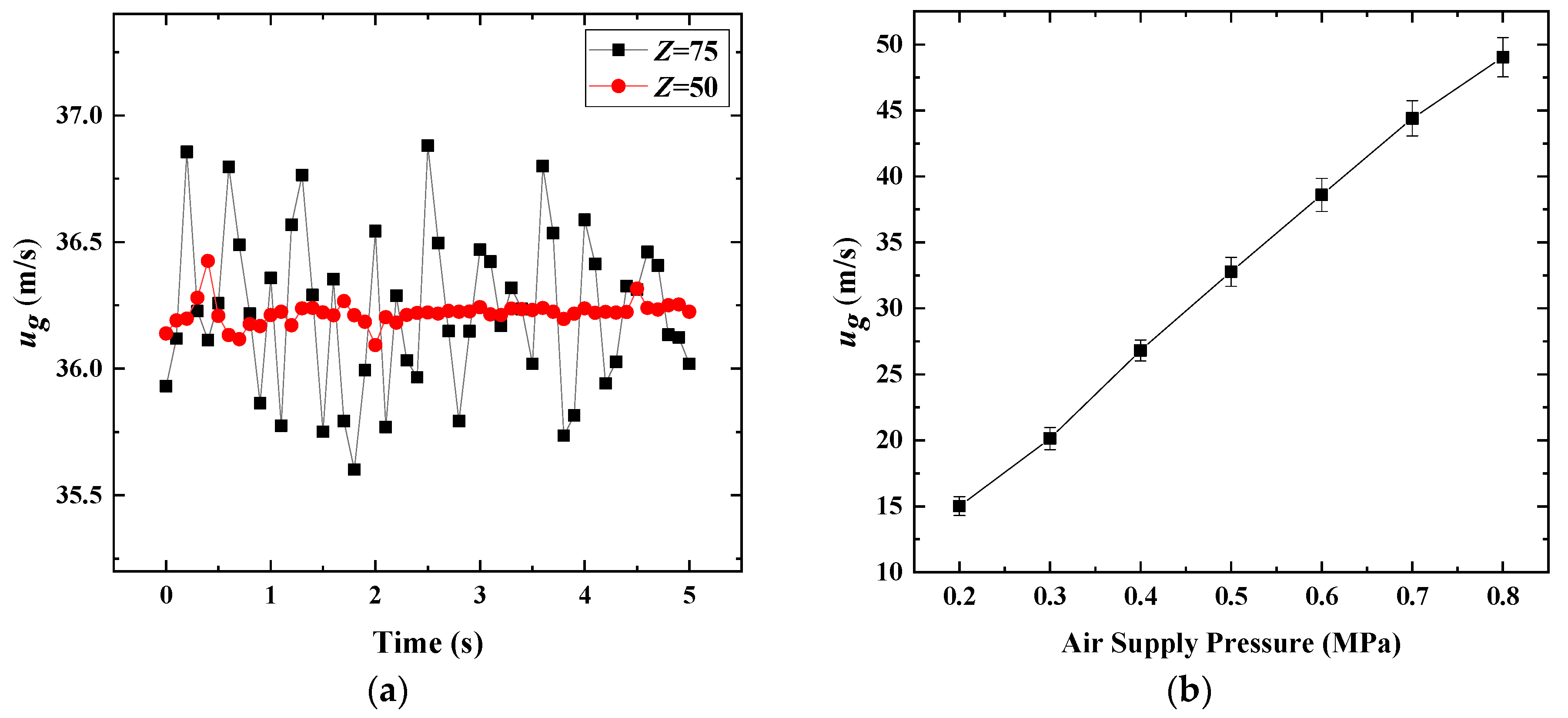
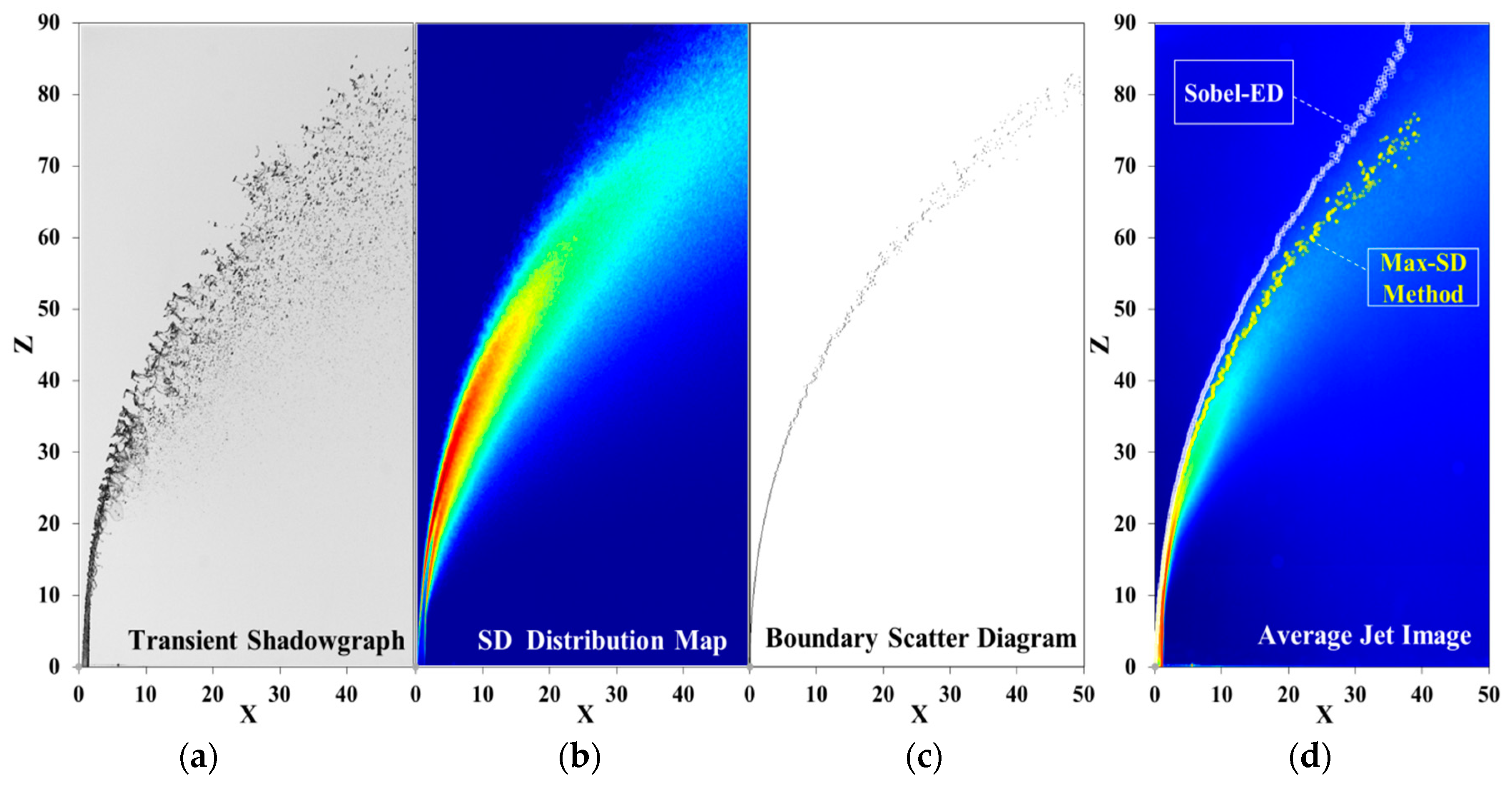
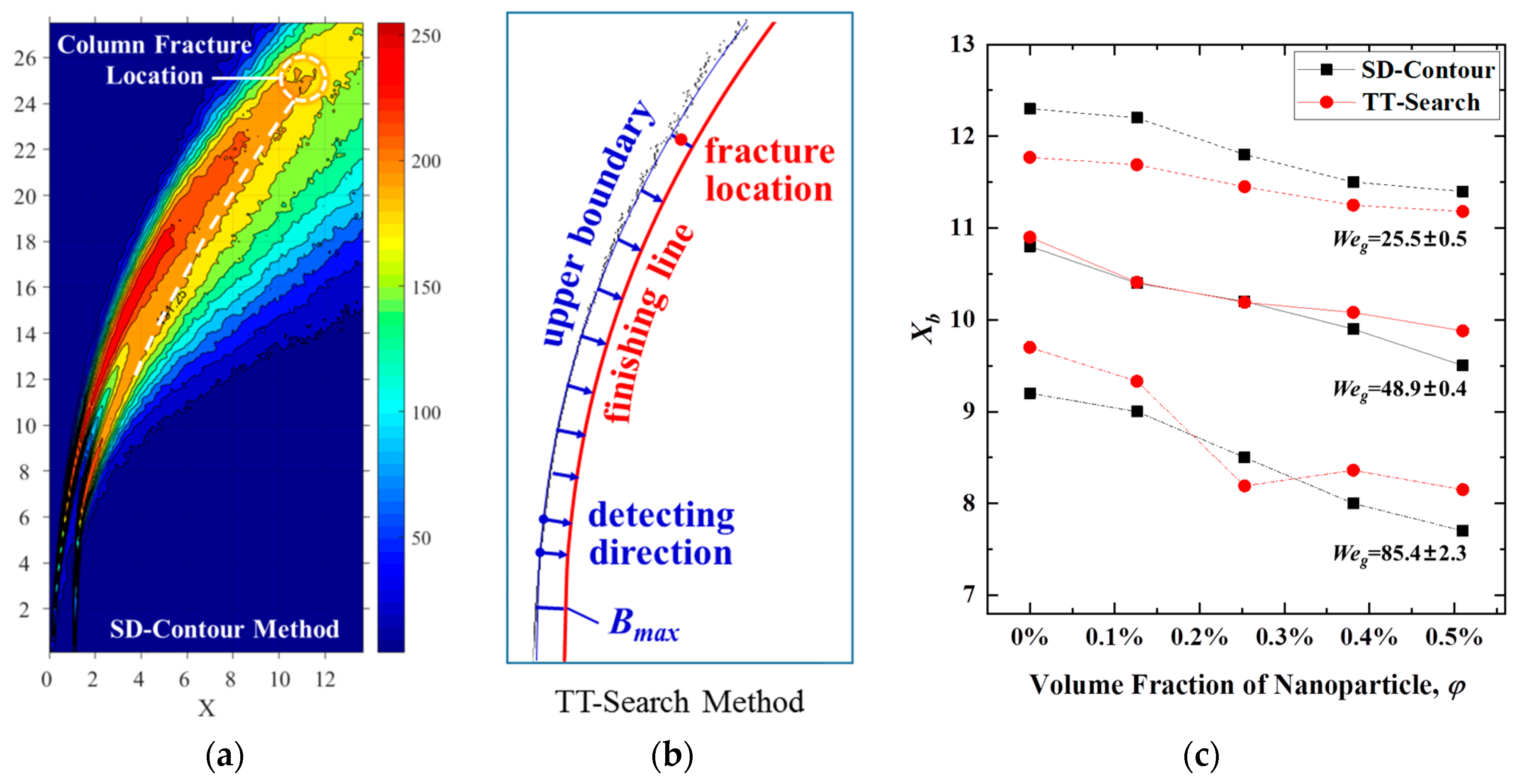

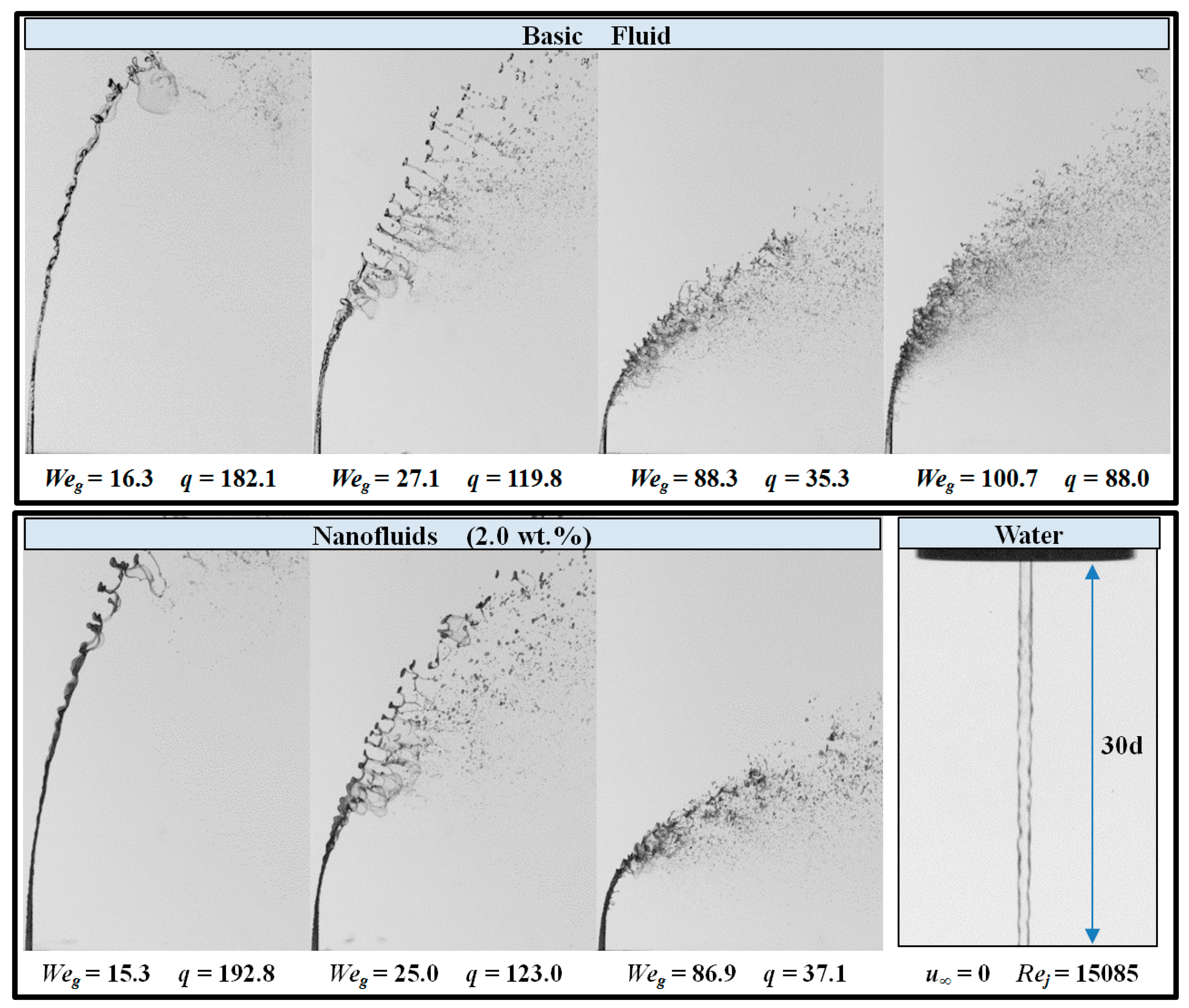
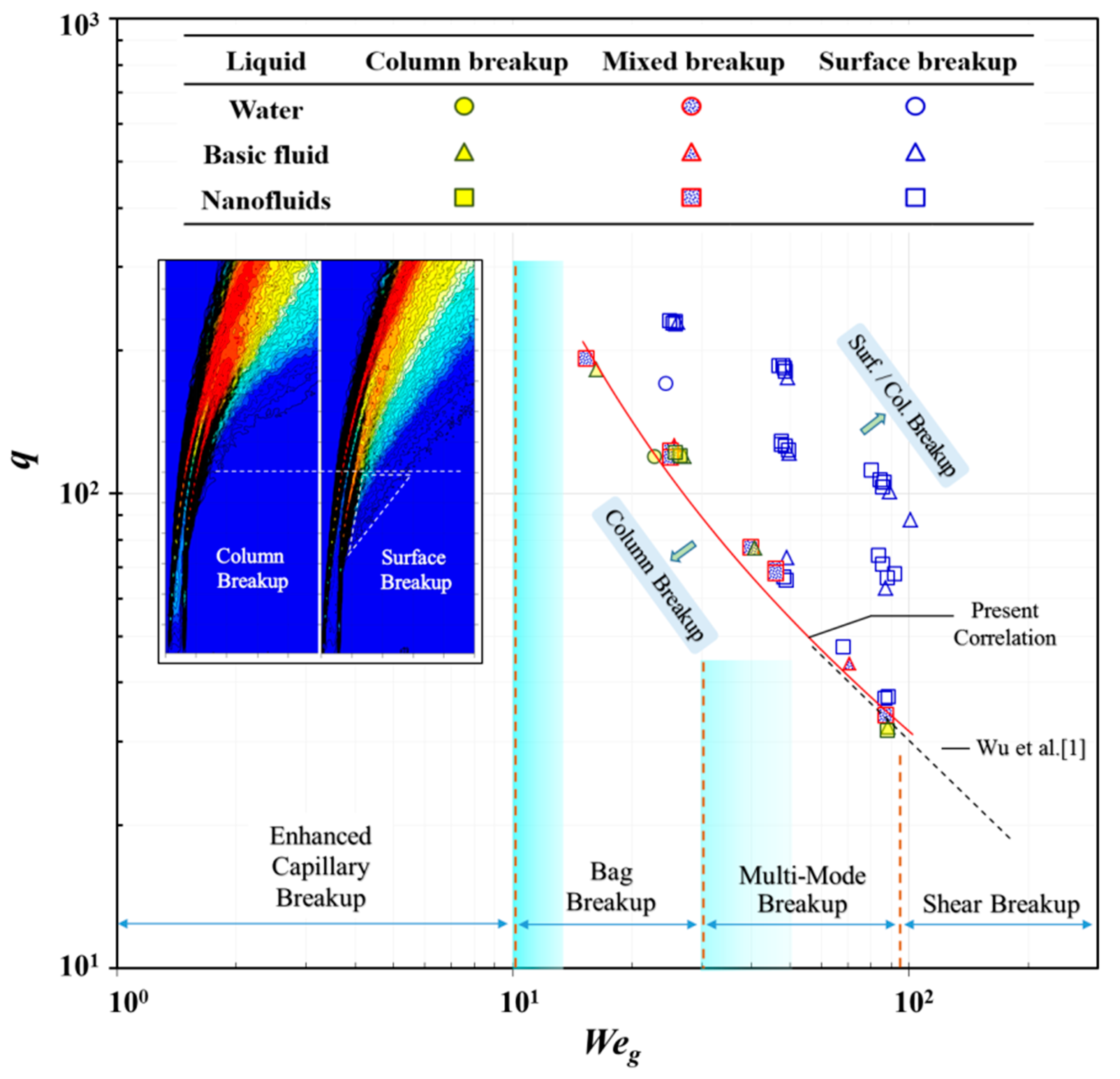

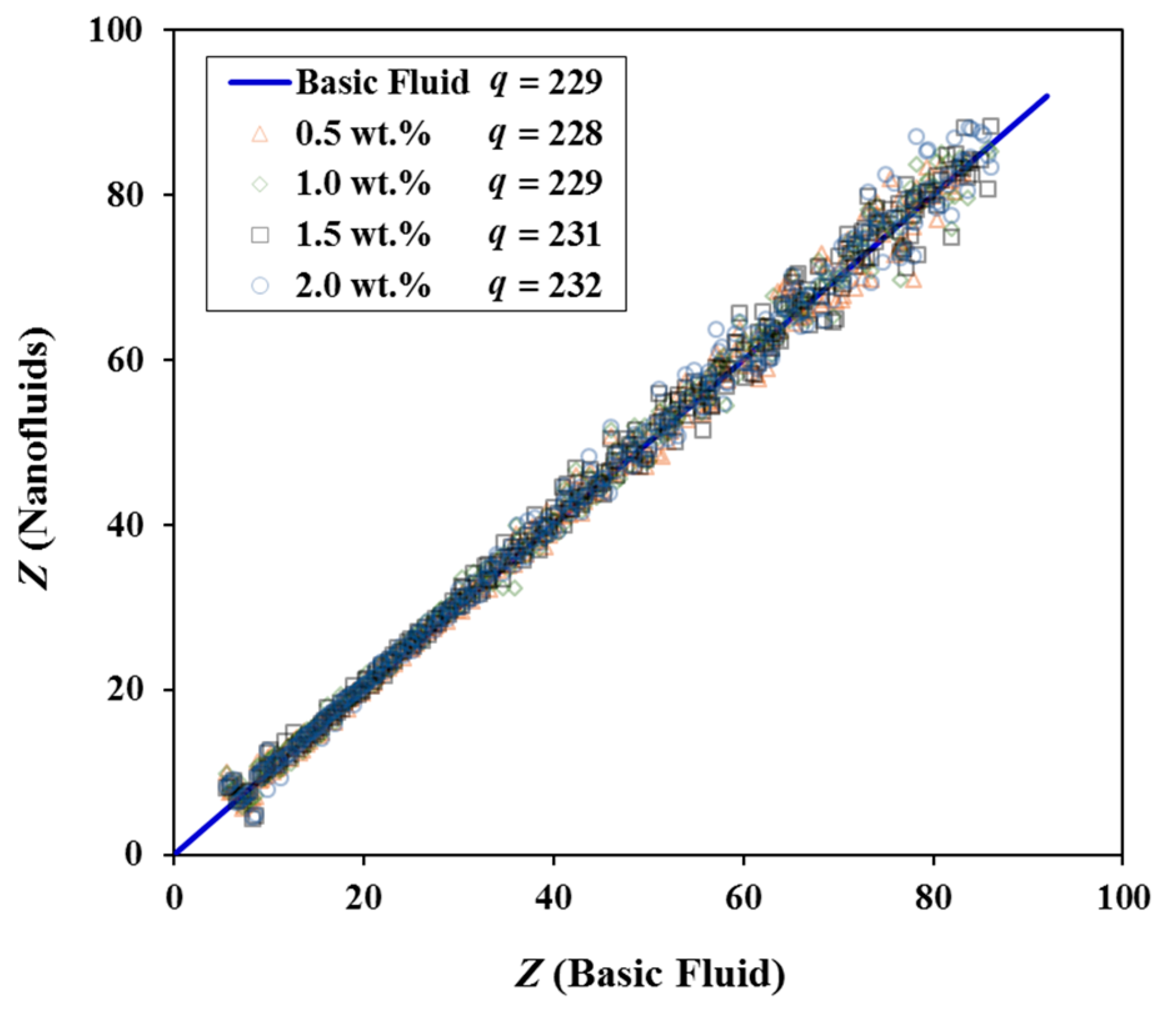
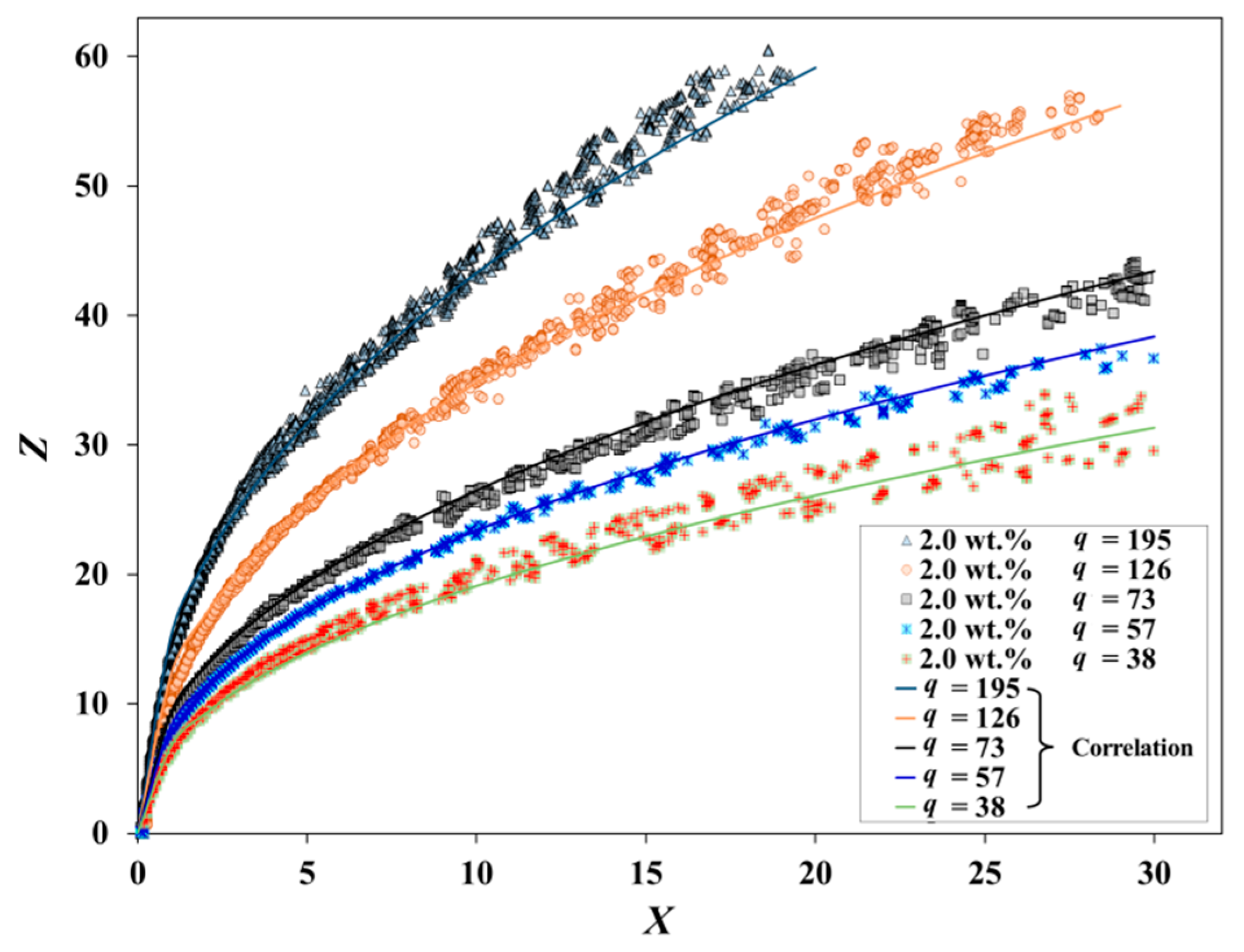
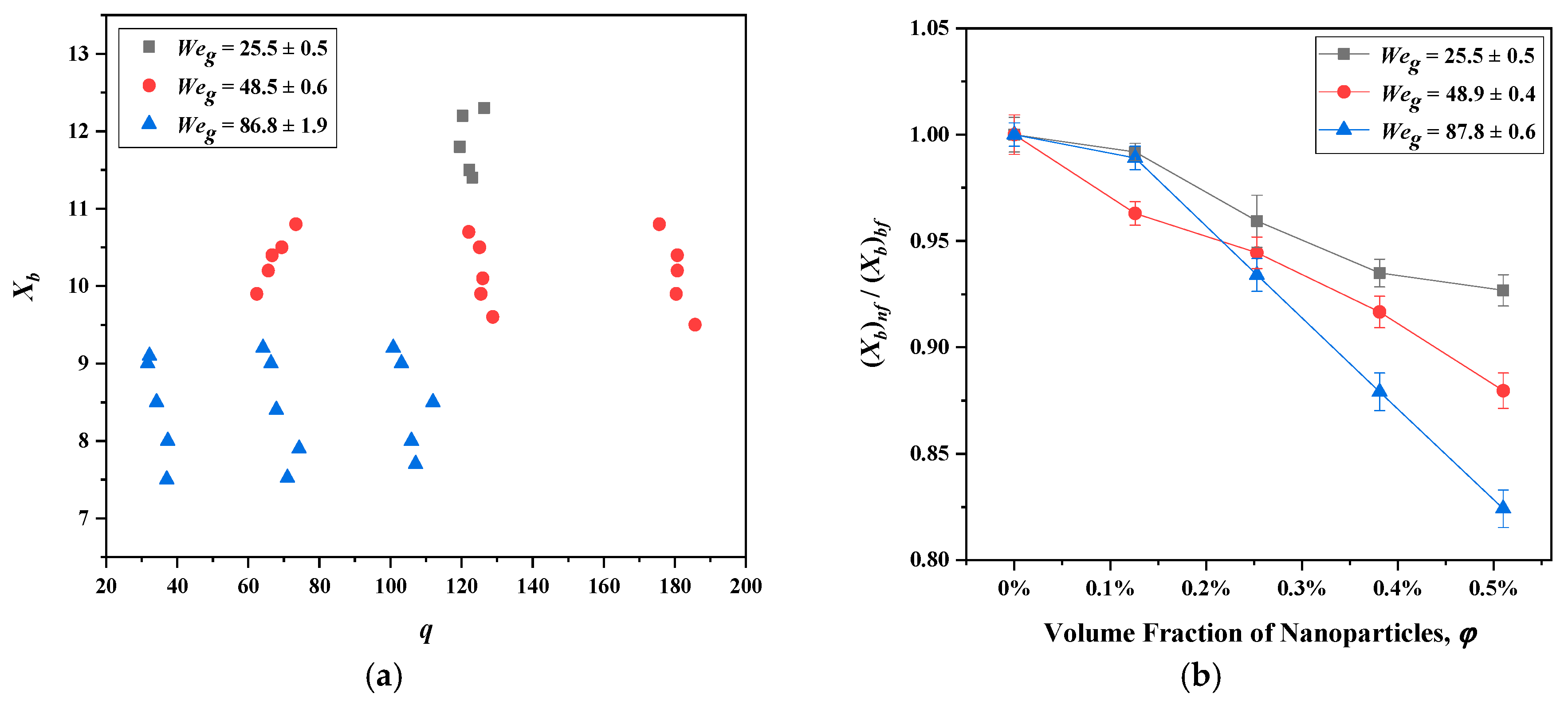
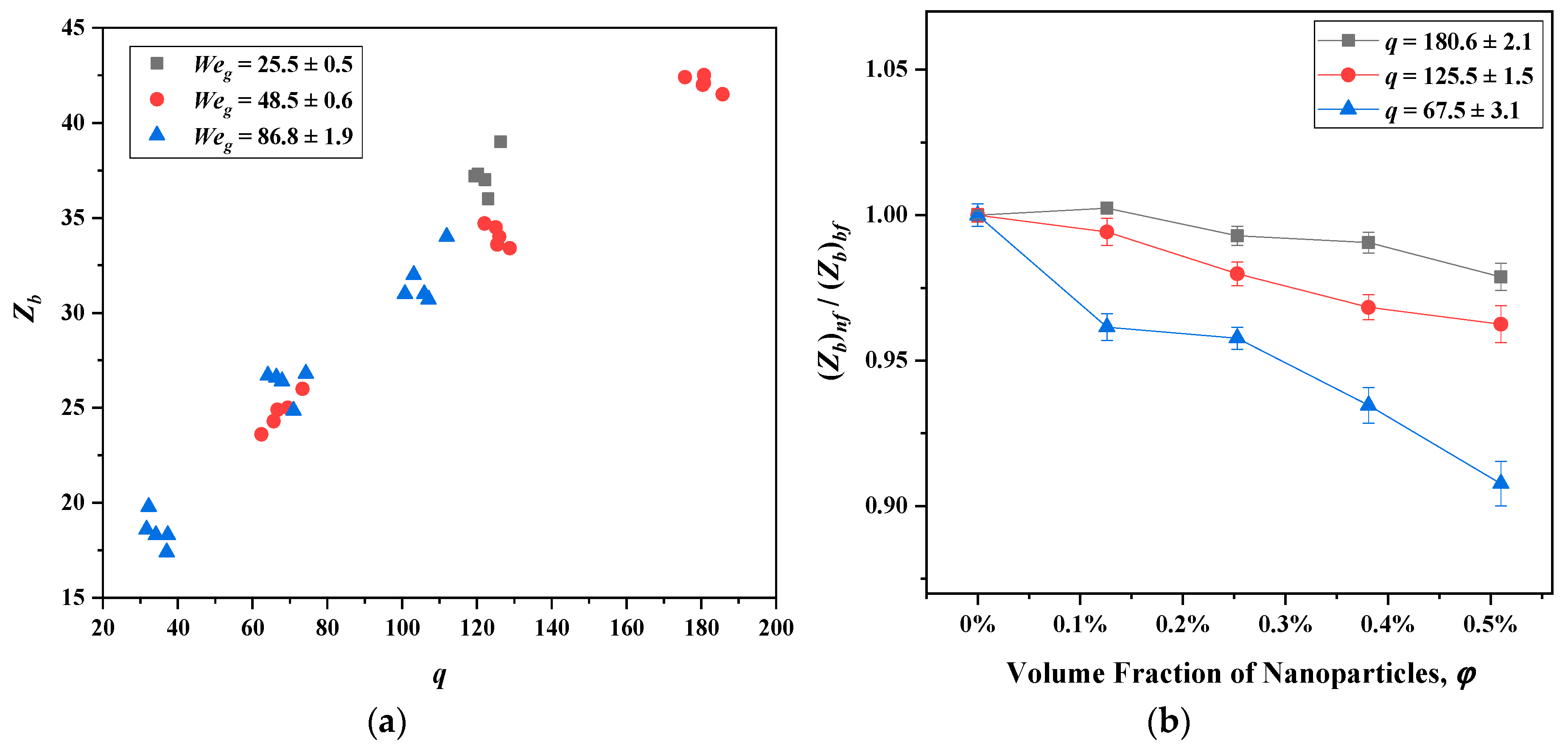
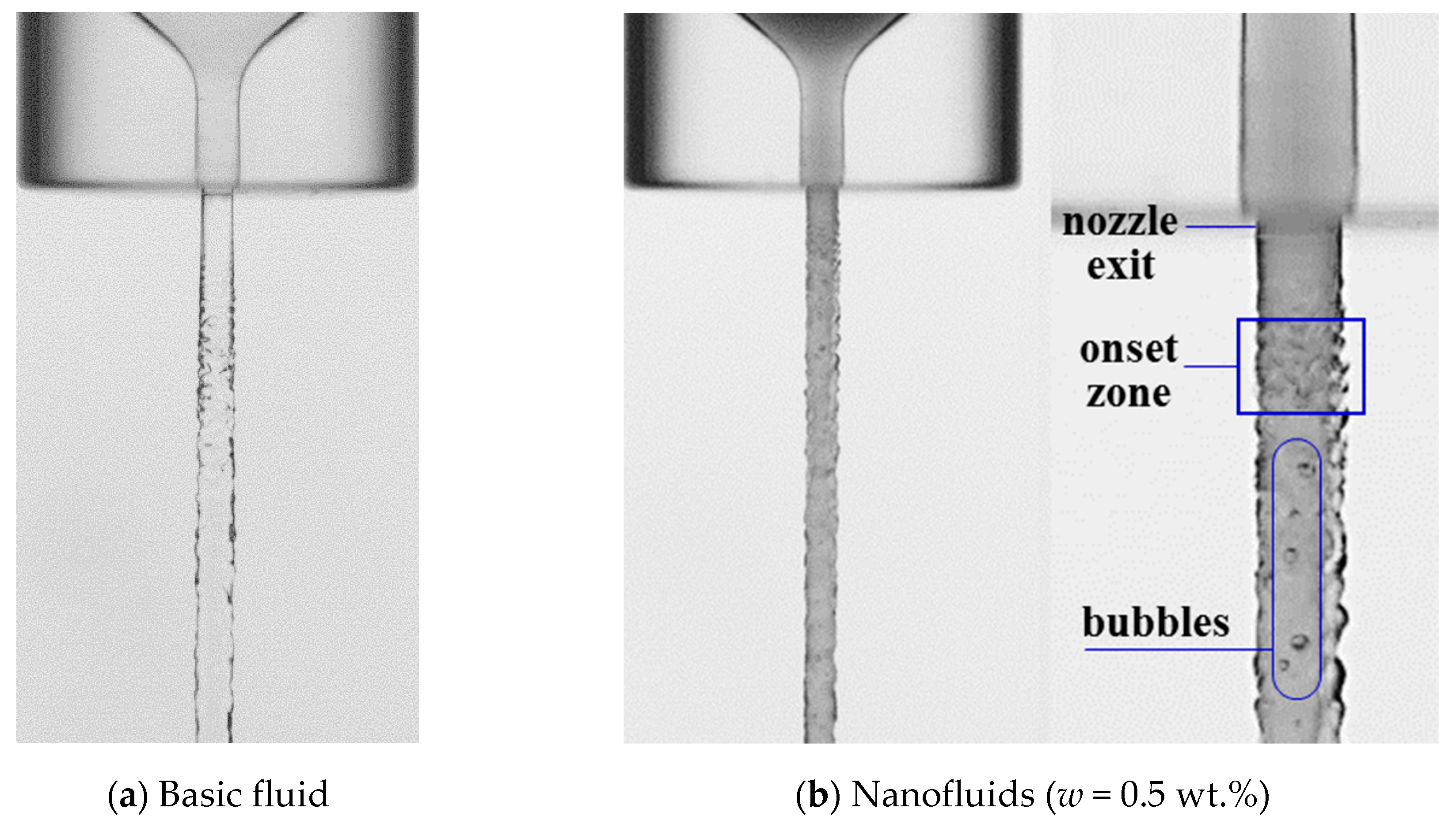
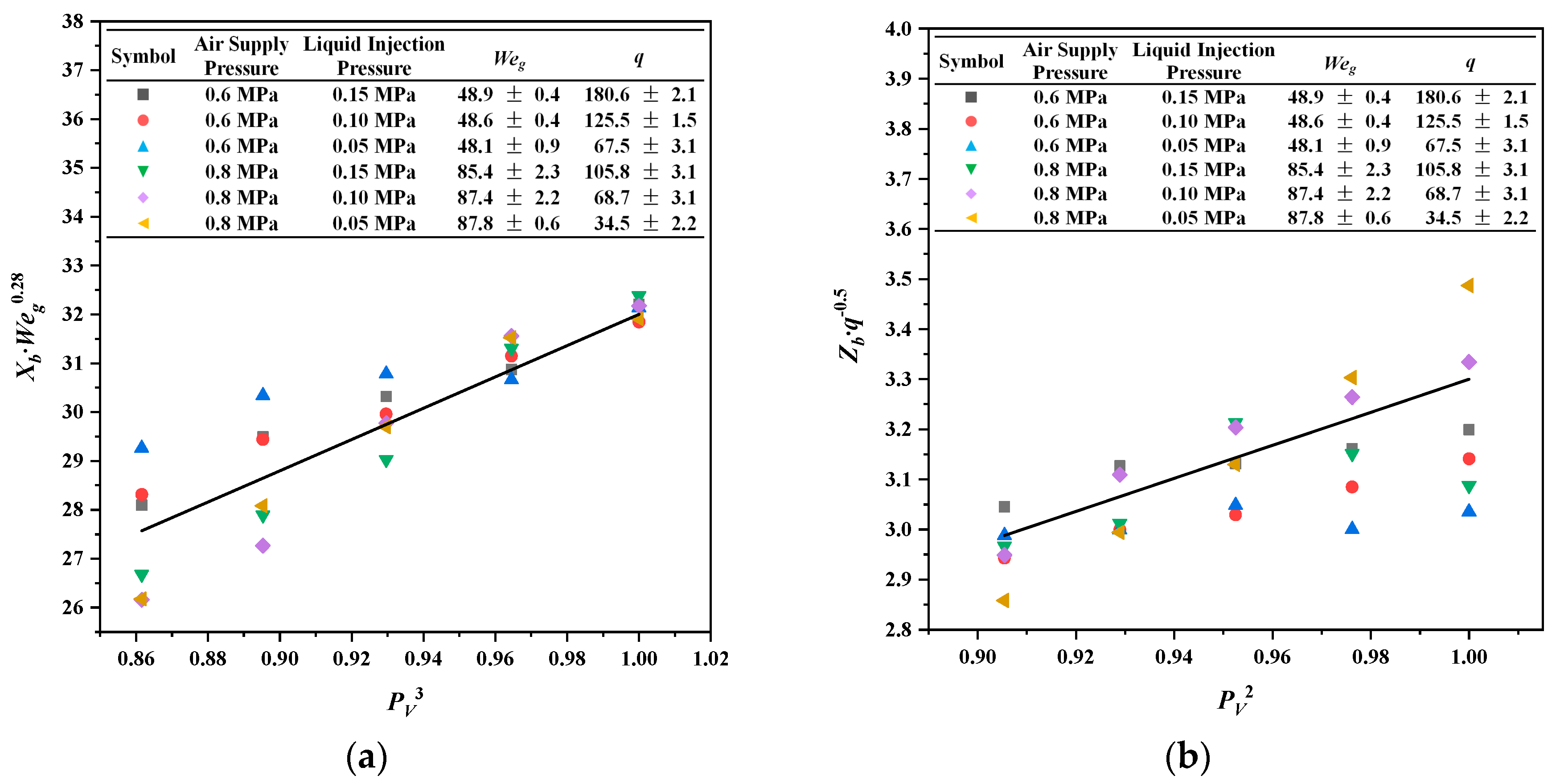
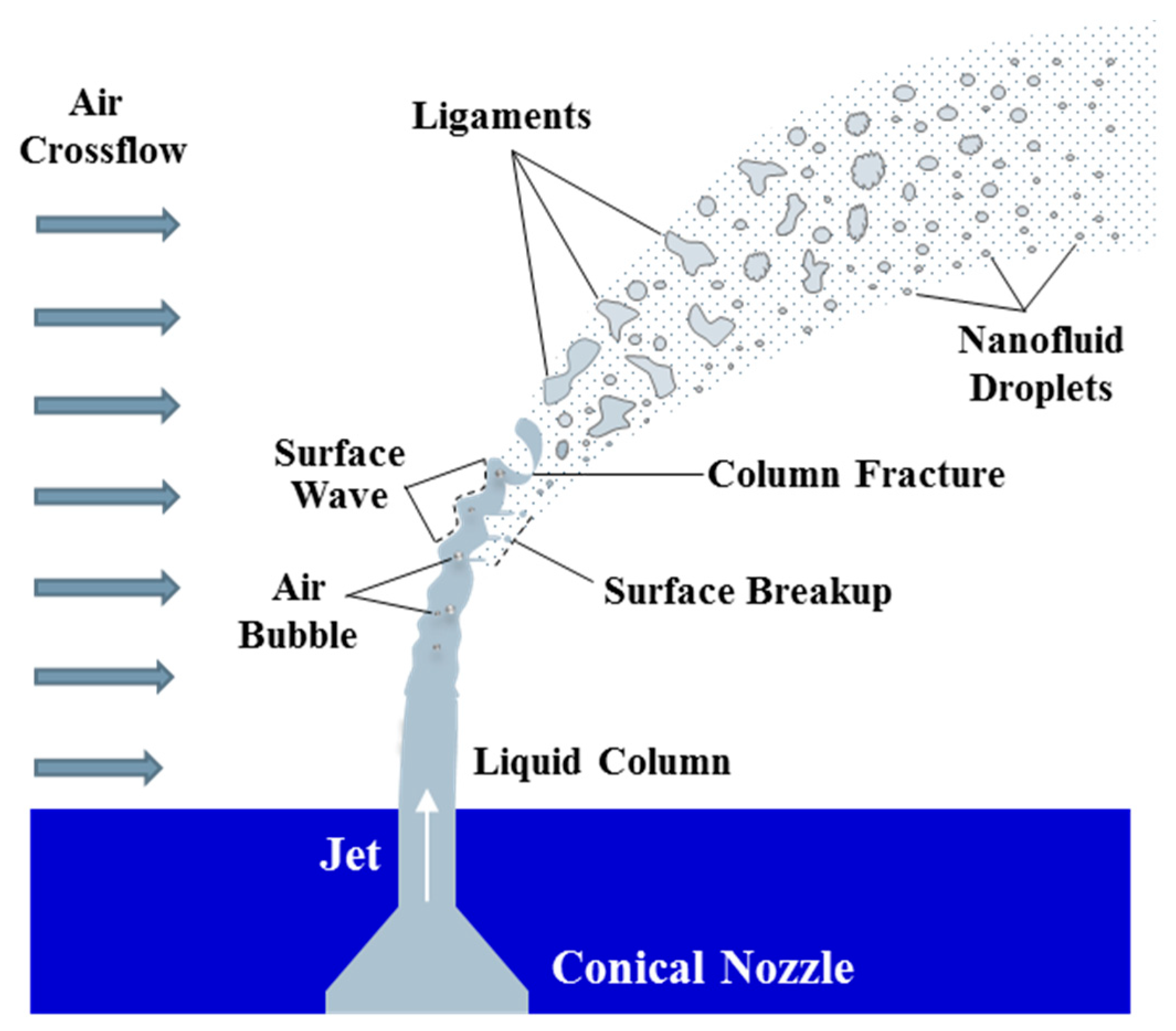
| Liquids | DI Water | Basic Fluid | Nanofluids |
|---|---|---|---|
| Nanoparticle concentration (w) (wt.%) | 0 | 0 | 0.5/1.0/1.5/2.0 |
| Density (ρL) (kg/m3) | 997.1 | 997.1 | 1000.9–1012.3 |
| Viscosity (μL) (mPa·s) | 0.894 | 0.897 | 0.987–1.106 |
| Surface tension (σ) (mN/m) | 71.97 | 32.31 | 32.58–33.15 |
| Fluid | DI Water | Basic Fluid | Nanofluids |
|---|---|---|---|
| Air Crossflow Velocity (u∞) (m/s) | 36–40 | 20–56 | 20–50 |
| Liquid Jet Exit Velocity (uj) (m/s) | 10–17.3 | 9.5–17.1 | 9.5–17.3 |
| Liquid Reynolds Number (Rej) | 11157–19302 | 10563–19013 | 9083–17442 |
| Crossflow Weber Number (Weg) | 22–26 | 15–101 | 15–92 |
| Momentum Flux Ratio (q) | 56–167 | 32–234 | 32–232 |
| Liquid Jet Ohnesorge Number (Oh) | 0.0033 | 0.005 | 0.0055–0.006 |
| Liquid/Gas Density Ratio (ρL/ρg) | 841 | 841 | 845–854 |
| Liquid/Gas Viscosity Ratio (μL/μg) | 49 | 49 | 54–60 |
© 2020 by the authors. Licensee MDPI, Basel, Switzerland. This article is an open access article distributed under the terms and conditions of the Creative Commons Attribution (CC BY) license (http://creativecommons.org/licenses/by/4.0/).
Share and Cite
Shi, W.; Li, F.; Lin, Q.; Fang, G.; Chen, L.; Zhang, L. Effects of Nanoparticle Additives on Spray Characteristics of Liquid Jets in Gaseous Crossflow. Energies 2020, 13, 1574. https://doi.org/10.3390/en13071574
Shi W, Li F, Lin Q, Fang G, Chen L, Zhang L. Effects of Nanoparticle Additives on Spray Characteristics of Liquid Jets in Gaseous Crossflow. Energies. 2020; 13(7):1574. https://doi.org/10.3390/en13071574
Chicago/Turabian StyleShi, Weidong, Fengyu Li, Qizhao Lin, Guofeng Fang, Liang Chen, and Liang Zhang. 2020. "Effects of Nanoparticle Additives on Spray Characteristics of Liquid Jets in Gaseous Crossflow" Energies 13, no. 7: 1574. https://doi.org/10.3390/en13071574





